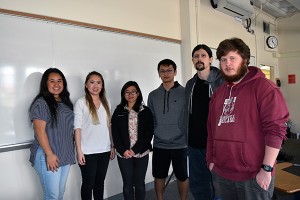15SJSU students intern with the campus’ Information Technology Services team to support student success.By Barry Zepel
Classroom-based learning provides the foundation for earning a degree; learning in a hands-on, real-life setting sharpens skills to prepare a student for a career.
That is just one part of the strategy behind the creation of the Altamont Center in Information Technology Services (ITS) at San Jose State University, where 16 students majoring in a variety of disciplines are completing internships that help them develop the marketable skills desired by corporations and other organizations in Silicon Valley. Interns work on projects involving data science, business intelligence, technical writing, software testing, software development and project management. Of the students, seven are undergraduates and nine are completing graduate degrees.
The students – who are in disciplines ranging from management information systems (MIS) to computer science to engineering to statistics – work closely with ITS staff on projects that move forward the goals of the department. The strategy is in line with SJSU’s Four Pillars of Student Success plan, with initiatives that support student engagement as a key pillar. Dana Nehoran, who serves as both a faculty member in the Lucas College and Graduate School of Business and a staff member in ITS, proposed the idea a year ago as a way to engage students through internships.
“The center employs students who are able to work on technical tasks related to their areas of study, while they also help achieve important goals and make a lasting impact on the campus community,” Nehoran explained. “Our student interns take part in essential projects that help SJSU provide more effective services for the entire student body.”
The students are mentored and supervised by full-time ITS staff members. The team Nehoran moves SJSU’s Four Pillars plan forward by identifying obstacles to student success, such as financial hardships, advising processes or inability to register for needed classes. The university can then focus resources on the areas that will have the most impact on improving graduation and retention rates. The interns are compiling and analyzing data, and ITS will distribute reports to help campus administrators make decisions about student success initiatives.
Together, the Altamont interns are providing San Jose State with predictive analytics. Nehoran describes it as “a discipline that attempts to make useful predictions about the future based on statistical analysis of historical data.”
“From the ITS point of view, we have this wealth of knowledge and capacity in these students,” said Bob Wrenn, SJSU’s interim chief information officer who oversees the department. “We have a lot of work to do here and we have a finite amount of resources to get it done. I can get students here who are highly trained and highly available; they’re on site and help complete the work we need done.”
The interns play an important role in the department, according to Wrenn.
“They are delivering real-life value working side-by-side with my permanent, full-time staff, who serve as their mentors and supervisors,” he noted.
Nehoran said the interns’ use of predictive analytics could have a positive impact for thousands of their fellow SJSU students, of whom 14 percent graduate in four years with the university focused on increasing that to 35 percent by 2025. The interns are analyzing historical information to find patterns that help identify students at risk of not completing a degree in a timely manner with the objective of enabling the appropriate campus services to provide proactive intervention.
While the interns realize that the “real-life experience” they’re getting will help them when seeking their first jobs after graduation, that isn’t all that is inspiring and exciting them.
“What we do here is going to add value to the campus community,” said Ryan Quigley, a second-year graduate student majoring in statistics. “We’re working under the umbrella of predictive analytics, which is using the data that the university has, to make predictions that are going to be beneficial to students’ lives.”
“Our main goal as Altamont Center interns is to make sure that the university’s resources are allocated efficiently. We don’t want (administrators) opening up class sections that are going to be empty, and we don’t want them closing sections that are going to be in high demand,” noted Quigley, who has already been offered a full-time position with a San Francisco-based financial institution as a result of his Altamont Center experience.
The internship program has had a profound impact on Nazia Khan, who like Quigley is a second-year master’s student and statistics major.
“I am totally a different person since I started (at the Altamont Center),” said Khan, who spent two years as a teacher in her native India after completing her undergraduate studies there. “I have more experience and confidence that I can survive in industry because of Dana Nehoran and the Altamont Center. I’m working on something that I am passionate and excited about because I am helping students to acquire their degrees and complete their education while helping to prevent them from dropping out because of emotional or financial reasons. We are able to help them by providing data to the professionals on campus responsible for directly helping those students.”
Additional information about the Altamont Center internships in the ITS Department is available by contacting Nehoran at dana.nehoran@sjsu.edu.
